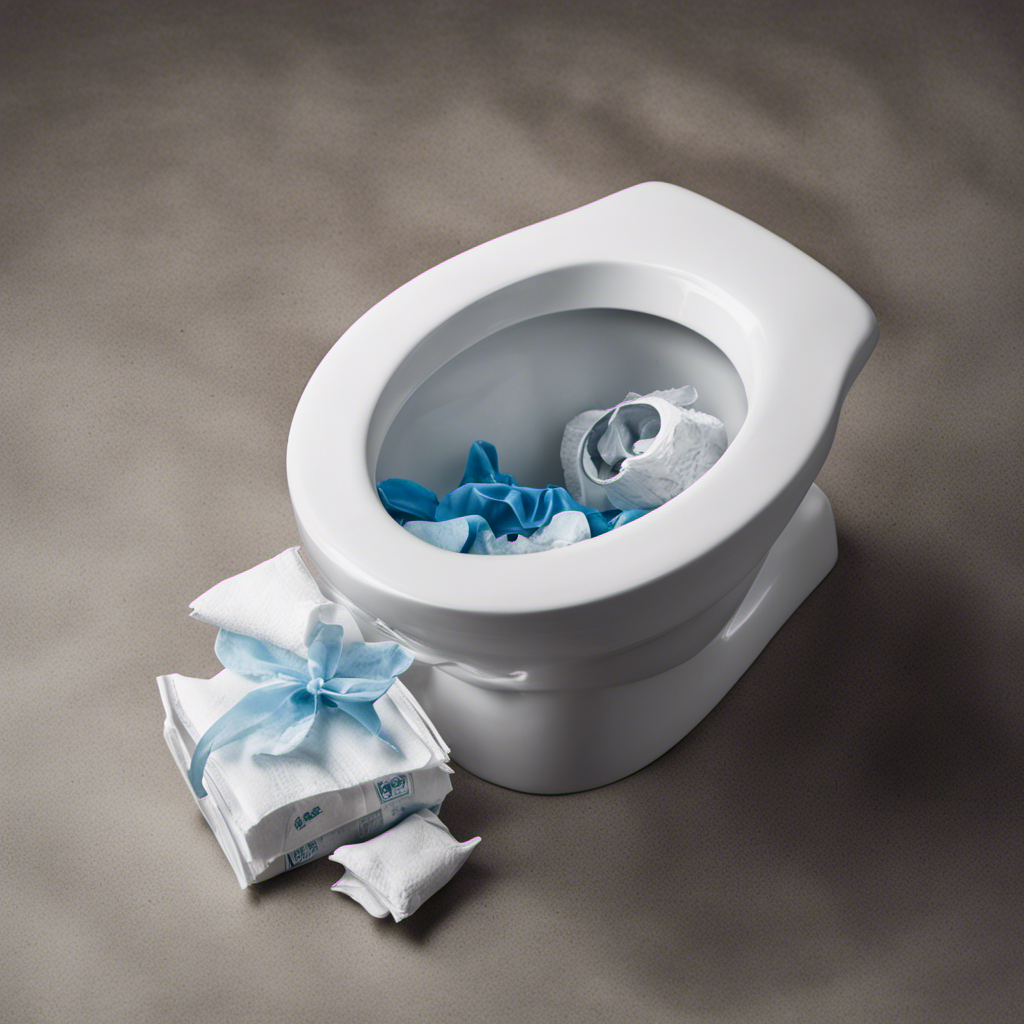Have you ever faced the annoyance of pushing the flush button on your toilet, only to discover that it doesn’t have the strength to properly clean the bowl? We comprehend your frustration, and in this article, we will explore the typical reasons for weak flushes and how to diagnose and resolve them.
From problems with the water supply to clogged flush valves and faulty mechanisms, we’ll provide you with the technical expertise you need to regain your toilet’s power flush.
Key Takeaways
- Clogged or blocked toilet trap, low water pressure, and clogged water supply line are common causes of weak flush.
- Regular maintenance, cleaning, and addressing clogs and blockages can improve flush power.
- Water supply issues such as insufficient water pressure, closed shut-off valve, or interruptions can weaken flush performance.
- Issues with the flush valve, flapper, or flushing mechanism can obstruct water flow and result in weak or incomplete flush.
Common Causes of Weak Flush
One common cause of a weak flush is a clogged or blocked toilet trap. The toilet trap is a curved section of the toilet bowl that holds water and prevents sewer gases from entering the bathroom. When this trap gets clogged with debris or waste, it restricts the flow of water and reduces the flushing power.
Another factor that can affect the flush strength is the toilet bowl design. Some toilet bowls are designed with a larger diameter and a more efficient shape, allowing for better water flow and a stronger flush.

Additionally, water pressure plays a significant role in the flushing process. If the water pressure is low, it can hinder the force of the flush and result in a weak performance.
Proper maintenance, regular cleaning, and addressing any clogs or blockages can help improve the flush power of your toilet.
Problems With Water Supply
Experiencing a lack of power flush in our toilets can often be attributed to problems with the water supply. When the water pressure is low, it affects the force with which the water enters the toilet bowl, resulting in a weak flush. Additionally, faulty plumbing can cause disruptions in the water flow, leading to inadequate flushing power.
Here are four common issues related to the water supply that can affect the performance of your toilet:

- Insufficient water pressure: If the water pressure in your plumbing system is too low, it can hinder the flushing action of the toilet.
- Clogged water supply line: Blockages or obstructions in the water supply line can restrict the flow of water, resulting in a weak flush.
- Partially closed shut-off valve: A partially closed shut-off valve can limit the amount of water entering the toilet tank, reducing the flush power.
- Water supply interruptions: Any disruptions in the water supply, such as water main breaks or maintenance work, can temporarily affect the flushing ability of your toilet.
To ensure a powerful flush, it’s essential to address these water supply issues promptly and seek professional assistance if needed.
Clogged or Faulty Flush Valve
We can encounter a lack of power flush in our toilets when there’s a clog or malfunction in the flush valve.
The flush valve is a crucial component that regulates the flow of water from the toilet tank into the toilet bowl during a flush.
If the flush valve becomes clogged or faulty, it can hinder the power flush and result in a weak or incomplete flush.

A clogged flush valve may occur due to mineral deposits, debris, or other foreign objects blocking the water flow.
A faulty flush valve, on the other hand, may not open or close properly, preventing the proper release of water into the toilet bowl.
Regular maintenance and cleaning of the flush valve can help prevent clogs and ensure an effective power flush in our toilets.
Issues With Flapper or Flushing Mechanism
Having a malfunctioning or worn-out flapper or flushing mechanism can contribute to a lack of power flush in our toilets. When the flapper, which is responsible for releasing water from the toilet tank into the toilet bowl, becomes damaged or worn out, it can prevent a proper flush from occurring. Similarly, if the flushing mechanism, such as the chain or lever, isn’t functioning correctly, it can hinder the flushing process.

Here are four common issues related to the flapper or flushing mechanism that can affect the power flush in our toilets:
- A misaligned or tangled chain that prevents the flapper from opening fully.
- A worn-out flapper that fails to create a tight seal and allows water to leak from the tank into the bowl.
- A broken or loose lever that can’t properly engage the flushing mechanism.
- A clogged or obstructed flapper that restricts the flow of water from the tank.
Addressing these issues promptly will help restore the power flush in our toilets and prevent further complications. Now, let’s move on to troubleshooting and fixing power flush problems.
Troubleshooting and Fixing Power Flush Problems
To troubleshoot and fix power flush problems, we can start by checking the water supply and adjusting the water level in the toilet tank. Insufficient water supply can lead to weak flushes, so it’s crucial to ensure that the water supply valve is fully open. Additionally, adjusting the water level in the toilet tank can improve the power flush. Too little water may result in weak flushing force, while too much water can cause overflow issues.
Below is a table outlining some essential tips for improving water pressure and maintaining the toilet bowl:

| Tips for Improving Water Pressure | Tips for Toilet Bowl Maintenance |
|---|---|
| 1. Clean the water supply valve to remove any clogs or debris. | 1. Regularly clean the toilet bowl to prevent mineral buildup. |
| 2. Check for any leaks in the water supply line and repair them promptly. | 2. Use a toilet bowl cleaner specifically designed for removing tough stains. |
| 3. Install a pressure-boosting pump to increase water pressure. | 3. Avoid using harsh chemicals that may damage the toilet bowl surface. |
| 4. Consider installing a larger diameter water supply line for improved water flow. | 4. Inspect the flapper and flushing mechanism for any signs of wear or damage. |
Frequently Asked Questions
How Do I Know if My Toilet Has a Weak Flush?
To determine if your toilet has a weak flush, observe the water pressure in the toilet bowl when you flush. If the water swirls vigorously and quickly drains, the flush is strong. If it moves slowly or doesn’t drain completely, the flush is weak.
Is It Possible for a Toilet to Have a Weak Flush Due to Problems With the Water Supply?
It is possible for a toilet to have a weak flush due to problems with the water supply. Issues such as low water pressure can affect the power of the flush. Toilet flush repair may be needed to address this issue.
How Can I Determine if the Flush Valve Is Clogged or Faulty?
To determine the location of a clog, inspect the flush valve for signs of debris or blockage. Look for reduced water flow and weak flushing as indicators of a faulty flush valve.
Are There Any Signs to Look for That Indicate Issues With the Flapper or Flushing Mechanism?
When troubleshooting weak flushes, it’s important to check for toilet flapper issues. Signs of a faulty flapper include water leaks, incomplete flushes, or a continuously running toilet.

What Are Some Common Troubleshooting Steps to Fix Power Flush Problems?
When troubleshooting weak flushes, start by inspecting the toilet flushing mechanism. Check for clogs, debris, or faulty parts. Clean or replace as needed. Don’t let power flush problems leave you feeling flushed!
Conclusion
In conclusion, if your toilet lacks power flush, it’s likely due to problems with the water supply. This can include low water pressure or a restricted flow of water into the toilet tank.
Another possible cause could be a clogged or faulty flush valve. The flush valve is responsible for releasing water from the tank into the bowl during the flushing process. If it is clogged or not functioning properly, it can hinder the power flush capability of the toilet.
Issues with the flapper or flushing mechanism can also contribute to a weak or ineffective flush. The flapper is a rubber seal that opens and closes to allow water to flow from the tank into the bowl. If it is worn out or not properly aligned, it can cause a weak flush. Similarly, problems with the flushing mechanism, such as a broken or misaligned handle, can affect the flushing power.

To restore the power flush capability of your toilet, it is important to troubleshoot and fix these problems. Start by checking the water supply to ensure proper pressure and flow. Inspect the flush valve for any clogs or faults and clean or replace it if necessary. Additionally, make sure the flapper is in good condition and properly aligned. If needed, adjust or replace the flushing mechanism.
Taking timely action to address these issues can help avoid further inconvenience and ensure your toilet has a strong and effective flush.










